‘Good for what ails you,’ bone broth has been soothing, nourishing and feeding people for thousands of years. During the Great Depression, which lasted from 1929 – 1939, bone broth was virtually a survival food for families who couldn’t afford meat and needed to extract as much nutrition as possible from the food they had.
Essentially bones simmered with a combination of vegetables, herbs and water; the process of making bone broth is eyes-shut easy and as frugal as it gets.
There’s no need to source anything special here, simply use the odds and ends of vegetables and herbs you have to hand. Carrots, leeks, onions, shallots etc. are all standard fare for the stockpot, but feel free to add whatever you enjoy eating.
Related: 50 Tips From the Great Depression
Less Water, Less Space Needed
If you don’t have unlimited storage space, then add less water for a more concentrated and intense flavour. This type of broth has a firmer set and can be diluted with water to use.
This recipe is for chicken bone broth, but the process is the same for beef/other animal bones. The cooking time is necessarily lengthy to draw the minerals and nutrients from the bones, but you don’t need to do anything other than wait. We’ve given the stovetop method, but you can speed things up by using a pressure cooker, or even simmer the broth in a slow cooker for 12 hours on medium.
You’ll need:
- 1 cooked chicken carcass (previously roasted bones taste better, but raw will work just fine)
- Carrot, leek tops, onions, garlic etc.
- Woody herbs such as rosemary, bay or thyme
- Tbsp. of vinegar (cider, wine, balsamic etc.) – optional
Method:
- Strip any meat from the chicken carcass and place the bones into a deep stockpot with the herbs and vegetables. Add water to cover and the vinegar, if using.
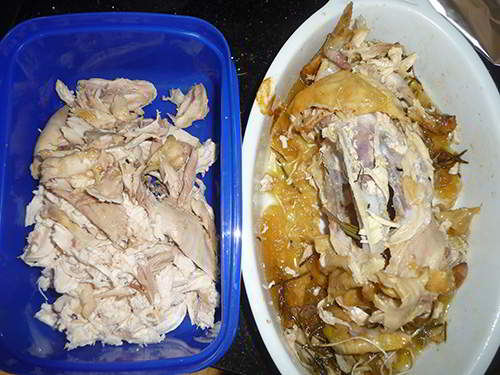
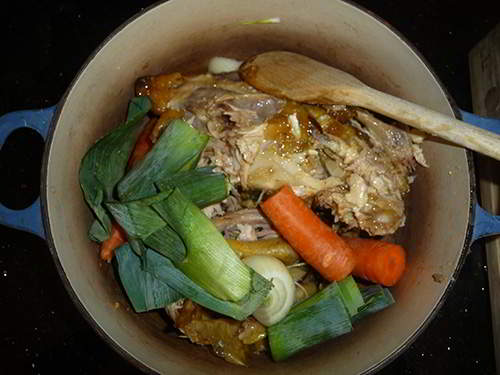
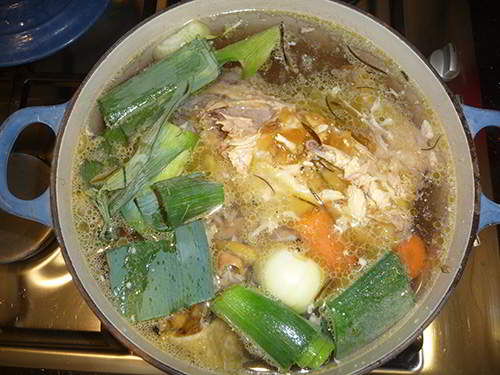
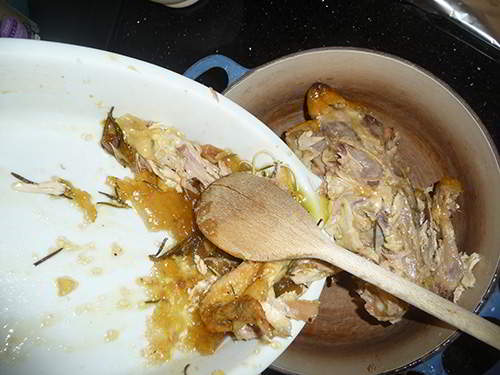
- Bring to the boil and leave on a simmer for between 12 – 24 hours. A couple of hours less than this isn’t a deal-breaker if you’re pressed for time. Top up the water as necessary.
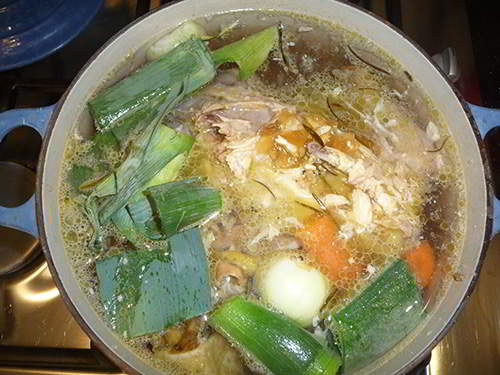
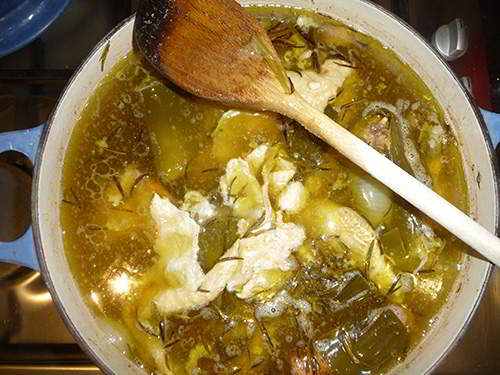
- When the bones are collapsed and the volume of liquid reduced, it’s time to strain the broth through a sieve into a clean dish.
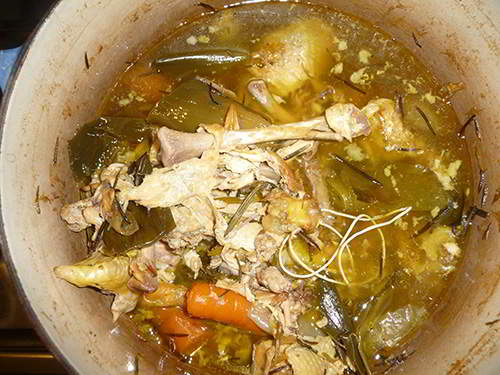
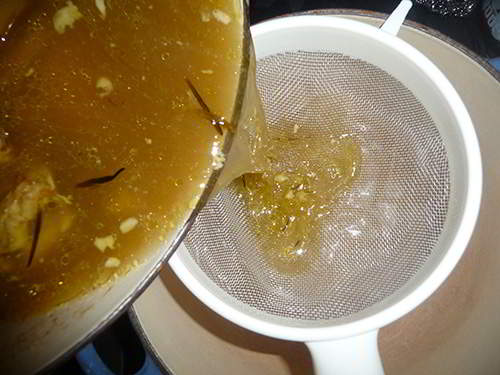
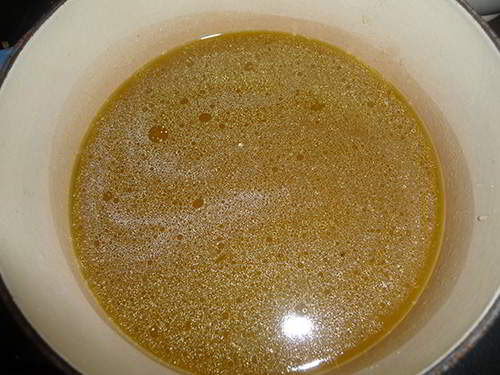
- Finally, strain again into sterilized jars and leave to cool before screwing on the lids.
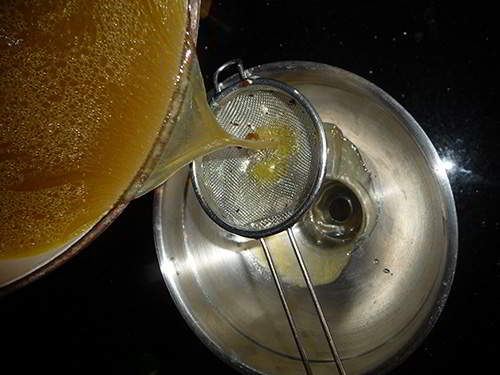
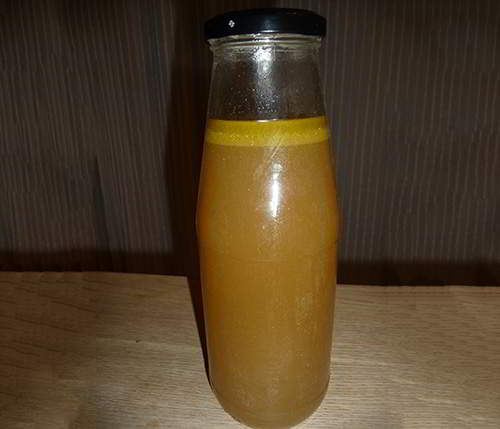
Storage
The broth will set to a clear jelly with a cap of fat. The ‘cleaner’ the broth, the longer it will stay good for. You can store this in the fridge for a good two weeks, spooning out what you need for soup bases, stews and so on. Bone broth freezes well, with a freezer life of 12 months.
You can increase the store cupboard life of your jars by processing in a pressure canner for 20 minutes at 10 pounds pressure for pints and quarts for 25 minutes (check manufacturer’s instructions and adjust for altitude). Bone broth canned this way should have a shelf life of at least 12 months.
This golden, richly flavored broth can be used in hundreds of dishes to boost the flavor, but it’s pretty awesome just seasoned and sipped from a bowl!
You may also like:
 All Churned Up – Making Your Own Delicious Butter
All Churned Up – Making Your Own Delicious Butter
World’s Smallest Battery Powers House For 2 Days (Video)

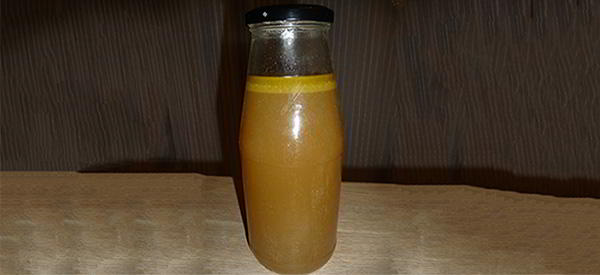













I’ve been doing this for years. I’ve also made gravy from bone broth.
Growing up in a family of 12, where both parents lived through the depression as kids, we had this a lot. We called it boiled dinner. Never did a bone go to waste and after used the dogs got them. Nor did we ever lose or injure a dog from chewing any kind of bones. As Izzy says, we also made gravy.
I’ve never known a dog to be hurt from bones. I always can chicken with the bones. The smaller bones are like canned salmon bones. The knuckles on the biggest bones get soft. Adding vinegar leaches calcium from the bones. If you put a boiled egg in pickle vinegar, the shell will completely dissolve over time.
Does this apply for wild game as well
Bone broth can be made from any type of bone. It is the marrow that you are extracting by doing this. The thicker the bone is, it will take longer to break down – why chicken is commonly used.
Now I’m Hungry. do you have a deliver service.
Sorry I didn’t read the whole thing, to much going on right now.I’ll get to it after the stock market ends today then I’ll really say what I think
I add the veggie matter the last hour or so and the woody things in the last 2 hours, otherwise the flavor gets cooked out to much.
Martha, correct. Thank you for the reminder. ♥
I’m glad that someone else mentioned it first. Cooking vegetables for 12 hours destroys any food value that they might have had.
Also, if you do a final heat-up/boil in the mason jars, a pressure canner works best, then it will do a final sterilization. Put the lids on hot, and when it cools the jars will be vacuum sealed… this is much better for longer storage.
dp
It doesn’t destroy everything; but, denatures some of the vitamins and makes the vegetables rather mushy.
It’s not quite that easy for low acid foods like this. You can put the broth in the jars hot; but, then you must pressure can at the proper time and temperature to ensure any Clostridium Botulinum spores are destroyed.
If you have added enough vinegar to have a pH of 4.6 or lower (better measure it) then you don’t need the pressure canner.
To kill the Clostridium Botulinum you need a temperature of at least 240°F for 10 minutes so only boiling will not do.
So the article says simmer 12-14 hours. I’m a practical kind of guy and don’t want to spend more money preparing the food than what it cost to just buy a grocery store. Doesn’t that seem like using up electricity for that long would cost more than the end product is worth?
Correction 12-24 hours.
Wannabe; This is for survival. You may not have electricity, and would use a wood/ propane/charcoal,etc. fire. And, since I cook, nothing you buy in a grocery store is THIS GOOD. You are using up old bones from your chicken or turkey, or beef bones. The idea is to use everything, you would normally throw away. THINK SURVIVAL and no grocery store. ☺
Bones is bones..and are Great…
However in all cases a sound rule of thumb is to not use and avoid handling the Spinal Column or Brains of any animal. ( Ribs for example cut well away from these areas and dispose of insuring no animals domestic or otherwise can access it.
There are cultures which do eat brains and such. However this carries a risk of contracting Sponge Form Encephalopathy an incurable disease..
So be Western and be Safe..
This is an illness that is largely avoidable and a quick read will explain it and means to avoid it in better detail than I.
https://en.wikipedia.org/wiki/Transmissible_spongiform_encephalopathy
Clarification
“Ribs for example .. (among my favorites)
However if doing your own butchery be sure study up and then to cut well away from the spinal column
Can this be done in a crockpot instead of on stove top? Seems like that would be more energy efficient
Wannabe; Are you, not reading this article? lol you keep this up and you will be one of those who will NOT survive.
Are you joking with your questions? Any heat source will work. How do you think pioneers did this?
I understand the electricity thing, I’m thinking stocking up on this staple while there still is electricity. Just don’t want to run a stove and cost more in electricity as opposed to a smaller device such as a crockpot. I love this idea and want to make it cost effective now?
Wannabe,
It’s only good for 12 months at best. How long did you plan to stock up for? I feel compelled to repeat the “read the articles” comment here.
Wannabe, the article states you can prepare the broth in a “slow cooker” which is the same as a “crockpot”
Hmmm the article said in a crock pot on medium for 12 hours. Put the pipe down.
I make this at least once a month using a large slow cooker. I let it go for at least 24-48 hours on low to extract as much goodness as possible. I use the broth in all my soups, sauces and gravies, and is delis all by it’s self. I have at least at cup full every day!
Natural ACV (with the mother) is an essential ingredient to help draw out nutrients from the bone and marrow. Using a small amount will not affect the taste.What you ultimately want is a broth that is more gelatinous than watery. That shows you’ve gotten the collagen, which distinguishes bone broth from stock. There is debate about whether or not to roast the bones first.
Using a crockpot is fine. If you heat with a woodstove, you can keep a continuous pot going, adding bones/veg daily and using what you need and preserving as you want.
Thanks for this wonderful idea I will be doing this.
Love this but if canning for storage it must be processed 90 minutes at 10psi or you might not live to enjoy your next jar!
I have an old book that takes this a step further by simmering the strained broth until it is reduced to the point that it becomes solid when cooled, think jello jigglers. It can be carried in you pocket, they called it potable soup, and will keep a very long time. I add salt to the broth for its leaching action and to help preserve the concentrated stock.
I remember reading a book on hunting that mentioned a disease called chronic wasting disease that effected deer and cautioned against using marrow, brains, etc, but I thought domestic (U.S.) cattle didn’t have mad cow and were safe to use. Can anyone help clarify?
we have mad cow. several years ago a dairy cow in washington state had it. i suspect there were more that went unreported. sheep get a similar disease as do squirrels, deer, elk, etc. it has been noted in several deer and elk herds by hunters. any mammal can get this. it is uniformly fatal. there is no treatment.
additionally. roasting the bones adds flavor and a nice brown color to the otherwise gray-ish broth. wine can be used instead of vinegar for additional flavor. if the vegetables are cooked to mush, the vitamins mostly end up in the broth. generally, the veggies are strained out before canning. if left in, the time noted for canning is too short. you would need to check the times needed for stew rather than broth for that.
where i live in western oregon, bone broth is $3 for 8 oz. you can use a lot of electricity making your own and stay under that!
You forget the grocery shelves will no doubt be empty so where u gonna buy anything. DUH!!
Has anyone tried this with an Instant Pot?
Instead of burning fuel for 12-24 hours, it might get done a bit faster and use a bit less energy.
We just got our instant pot a month or so ago and are just now playing with it.
I’ve used both a pressure cooker & pressure canner a lot, and a roast cooked in these falls apart with the bones often going soft.
sounds good and easy; I have no pressure canner, afraid of them; momma was a nurse and told us of all the burns etc that happened in the emergency room…love canning, but never got over the fear of the pressure canner exploding…so guess I’ll just freeze mine for awhile.
During a debilitating gut issue, I was consuming a lot of homemade bone broth. A friend happened to stop by and asked what stunk. The smell made me nauseous several times, but not knowing better I kept purchasing beef bones from my local butcher. My friend said to only use organic bones. A big difference – hardly any smell. To think I was putting whatever the cows were being injected with/fed, makes me cringe.